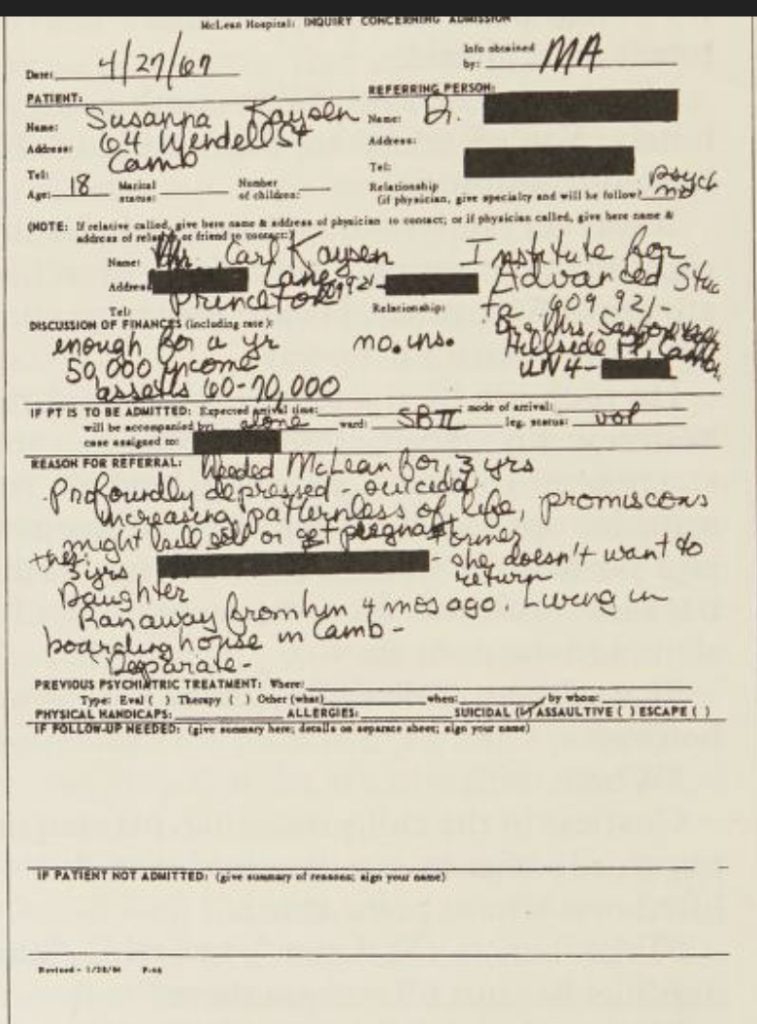Before the movie of the same name, there was Susanna Kaysen’s 1967 book: Girl Interrupted. A book that highlighted life in a Massachusetts mental institution for the rich; a book that highlights teenage girls’ obsession with diets, figures, and Ex-Lax; a book about racism; a book about drugs, suicide, and incest; a book about institutional power and surveillance. Susanna Kaysen wrote about these day-to-day activities while in a mental institution.
At the beginning of the novel, Susanna gives the readers some official government forms. One form outlines her doctor’s recommendations to admit Susanna to a mental health facility. Another form outlines the cost of treatment: 60000 grand for a year stay in 1967. Other forms are reports of Susanna’s progress as outlined by medical staff.
The novel is quite ordinary in explaining teenage girls’ obsession with dieting. Susanna delves into great detail about girls who never ate. Also, Susanna talks about always being on a diet or the Ex-Lax provided on ward.
For Susanna, race is an issue in her diary. She talks about Lisa, a close friend of hers on the ward, who says the authorities will just shoot Dr. Martin Luther King if he stirs up too much trouble-something they actually did later. Susanna, too, goes on to write about Bobby Seale, a cofounder of the Black Panther political party, who was gagged just so he couldn’t be heard in court. Susanna, intentionally or unintentionally, fails to mention no African American girls in the rich mental health facility.
In her diary, Susanna explains drugs in detail on the ward. She tells us that Thorazine was a common used drug-the drug was compared to a chemical lobotomy. As well, all kinds of drugs were used on the girls to keep them docile. Of course, this was a time when mental health-especially for 1960s and 1950s bored hysterical house wives-was solved with a pill due to big pharma.

Susanna touches on suicide and incest. She mentions a girl named Daisy who killed herself; and, she says Daisy was sexually abused by her father who brought her chicken.
Susana discusses Freud in her diary, too. She says mental health is an industry where you confess your sins and are saved. She goes on to talk about Freudian psychoanalysis: you talk about your feeling to get to the root of what’s bothering you. Finally, she talks about the ego, super-ego, and the Id.

The novel examines power too. Things like who called the shots on the ward are talked about. Also, the placement of the cells and nurses led to discussion of the panopticon-a Foucaultian sociology theorist big in the 1960s. Susanna gets into how the girls resisted on ward, too.
Susanna gets into some of the famous people who stayed at the mental institution. We learn Sylvia Plath, the novel writer, had a stint in the ward. Also, musicians like Ray Charles and James Taylor stayed on ward because of their drug addictions. Suzanna mentioned that something about the structure of music drove singers to addictions, too
Briefly, the novel is ok. It doesn’t blow up Lisa-Angeline Jolene-the way the movie did. Also, the novel doesn’t blow up Whoopee Goldberg, Valerie the head nurse. The novel seems to be an honest portrayal of day-to-day activities in a Massachusetts mental hospital for rich girls in 1967.